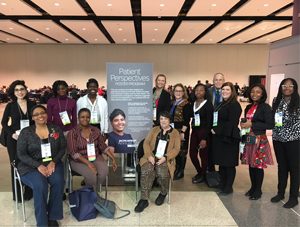More than 15,000 doctors, nurses, physical therapists, researchers, scientists and others with interest and/or expertise in rheumatology gathered in Chicago in late October for the American College of Rheumatology’s Annual Meeting. The Arthritis Foundation had a contingent of “patient representatives” attending to provide the perspective and voice of peopleliving with arthritis. They fanned out to attend sessions, view and present posters and collect information about exciting new developments in the field. Here are their notes from the final sessions of the meeting.
Medical Marijuana
其中一个会议引起了很多关注,那就是“临床大麻素辩论:安全性、剂量和可及性”,在这个会议上,威斯康星州富兰克林的风湿病和免疫治疗中心的阿尔文·威尔斯博士和科罗拉多大学医学院的杜安·皮尔森博士就在风湿病患者中使用大麻素(大麻中的活性化合物)的利弊进行了辩论,威尔斯博士支持大麻素,皮尔森博士反对。
“I found the session intriguing because this is relatively new in treating patients with chronic pain, and there is much more research needed,” says Gary Davenport, a patient representative who attended the session. “What really caught my attention was when Dr. Wells put data on the screen [showing that] in thestates where medical marijuana (MMJ) is legal, opioid prescriptions and opioid-related deaths are in decline.
“Dr. Wells went on to say that in the state of Illinois, if you are currently on doctor-prescribed opioids, the state will waive the $300 fee for an MMJ [user’s] license. So, is MMJ simply the lesser of two evils or does it have legitimate potential to become accepted in our society as a government-approved medicine?” he asks.
Emerging OA Treatments
另一个有趣的话题是“OA的新疗法:针对疼痛vs结构”。Dr. Anne-Marie Malfait from Rush University Medical Center in Chicago talked about disease-modifying osteoarthritis (OA) drugs (DMOADs), which could potentially change the course of thedisease. “As of 2018 there are no DMOADs on the market. There are several in the testing phase. The process can take years, requiring testing in the lab, in animals and then on humans. Each level must pass muster before it proceeds to the next level,” reports patient representative Donna Dernier.
“The second speaker was David Walsh, PhD, from the University of Nottingham in the U.K. He made the point that even if there were disease-modifying drugs available, as with [rheumatoid arthritis] RA, there is still pain. So drugs that work on pain alone are still needed. Some pain drugs in the pipeline block the pain signals from reaching the brain. Other drugs focus on nerve growth factor and blocking those pathways,” says Dernier, adding that more are needed.
德尼尔说,最后一位发言者,来自澳大利亚悉尼大学的大卫·亨特博士,更深入地讨论了几种药物在确定最佳剂量后进行人体试验的情况。“药物可以达到这种程度,但结果仍然令人失望。这也是发现意外副作用的时候,”她说。
TransitionCare for Children
Patient representative Corinne Pinter attended a session called “Pediatric Transition Approaches on Both Sides of the Pond” that explored thetransition of patients from pediatric to adult rheumatology treatment. “The adolescents and young adults don’t have the same brain; they are not mini-adults,” says Pinter. “Parents need to be involved, but adolescents and young adults need to learn how to take care of their condition and manage their health.”
Biosimilars
A lecture on “Biosimilars: How Do They Affect Patient Care and Safety?” elicited this comment from patient rep Rick Phillips: “Biosimilars can have a negative image, [making] it difficult for patients to accept [them as being] as good as the original. Education is the key to acceptance.” (Read more about biosimilarshere.)
Patient Education Around the World
The annual session of the International League of Associations for Rheumatology (ILAR), “Innovative Patient Education to Overcome Patient Barriers,” looked at patient-specific initiatives worldwide ineducation and awareness.
The first speaker was Dr. Christina Drenkard, from Emory University, who spoke about the need to reach Spanish speaking lupus patients in the United States, because educational materials are often in English. The Let’s Talk about Lupus campaign has been used “mostly on Facebook, and has attractive and friendly videos, online live chats, written information,” reports Dernier.
Dr. Omondi Oyoo, from the University of Nairobi, spoke of patient education initiatives in Africa. “The goal was to create awareness of musculoskeletal health and self-care techniques. They needed to get good information to people in far-flung villages. [Organizers] brought in international teams who trained special patient teams, who then trained regional patient groups… Long term, they need to get an online presence to share information among patients and clinicians.”
Dr. Syed Atiqul Haq, rheumatology professor at Bangabandhu Sheikh Mujib Medical University in Bangladesh, discussed patient education in the Asia Pacific region. “He spoke of the need for patients to buy in to the care offered by health providers. The goal [of the initiatives is] to support patients, help them to adjust to their illness and maintain their quality of life. [Those involved] found that patient education was the single biggest factor in adherence to the medical regimen,” says Dernier.
最后,欧洲风湿病联盟主席Johannes Bijlsma博士指出,欧洲使用的语言超过50种,“使得传播健康信息变得困难。在欧洲语言学院,他们有自我管理的在线工具,病人教育课程信息,以及志愿者标准,”德尼尔说。
Psoriasis and Arthritis
One of the last sessions at the conference was “Psoriasis to Arthritis Transition: Mechanisms, Risk Factors and Interventional Strategies,” in which Dr. Christopher Ritchlin, chief of rheumatology at the University of Rochester in New York, outlined some of the mechanisms involved in the transition from psoriasis, the skin disease, to psoriatic arthritis (PsA), the bodywide disease that affects joints.
Dr. Alexis Ogdie, from the University of Pennsylvania, outlined possible moments of transition from psoriasis to PsA. For example, a patient might start out with certain genetic or physical characteristics linked to PsA, then experience silent inflammation (as measured by certain proteins in the blood), then having achy joints and fatigue – all before changes in joints show up on X-ray. Dr. Ogdie posed the question of whether PsA could be prevented at different points in the continuum.
New York University’s Dr. Jose Scher outlined some of the major risk factors linked to the development ofarthritis in psoriasis病人,比如肥胖,有家族史;MRI或超声显示为“亚临床疾病”;有头皮或指甲牛皮癣或非常严重的牛皮癣。他讨论了如何更多地了解这种疾病的自然史,可能导致额外的策略,以防止PsA的发展或减轻银屑病患者的严重程度。
Related Resources:
- ACR 2018 Sessions Include Drug Pricing, OA Treatments, Diet as Therapy
- Patient Perspectives at the American College of Rheumatology Conference


